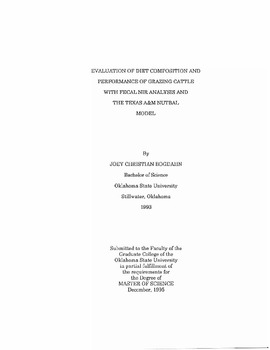| dc.description.abstract | As a result of the difficulty of determining the quantity and quality of ingested forage, evaluating the nutritional status of grazing animals is complicated (Coleman et al., 1989). The ability to accurately and precisely predict the quality of the grazing animal's diet and anim.al performance would assist producers making decisions concerning forage resource utilization, supplemental feeding regimes and marketing opportunities. Timely estimates of forage quality would provide information necessary to initiate or terminate supplemental feeding. Timely estimates could also improve grazing management decisions such as the movement of cattle through a rotational grazing system. Additionally, predictions of current animal performance would provide crucial budget information for producers considering alternative production and marketing options. Basically, there are two methods available to estimate the nutrient composition of a grazing animal's diet. Performing laboratory procedures on hand-harvested forage samples is a direct method to analyze the nutrients available for consumption. However, obtaining samples representative of the animal's diet is a problem. According to Holechek et al. (1982b), using fistulated animals for sample collection gives the most accurate representation of forage consumed by grazing animals. Unfortunately, this method of sample collection is not an option for producers. Several indirect methods have been proposed to predict diet composition, intake and performance of grazing animals. Indirect methods have used chemical constituents within grazed forage and fecal samples. Many of the chemical constituents in forage are highly correlated with forage intake and animal performance (Hom et al., 1979). Likewise, some chemical components of fecal material are also highly correlated with the chemical constituents of ingested forage (Holloway et al., 1981: Holechek et al., 1982c; McCollum, 1990). Historically, these equations have been less than satisfactory in accomplishing the goals for their development, especially for use on a large scale and generalized basis. The limited success of these relationships has been due to the many biological factors affecting intake and weight gain.. Numerous prediction equations may be required to account for seasonal changes in chemical and botanical composition of the grazed diet as well as diJIerences in vegetation type. Holloway et al. (1981) had to include several constituents in a single regression equation before acceptable coefficients of determination were achieved. Near infrared reflectance spectroscopy (NIR) has been proposed as a viable method for determining the nutrient composition of forages (Norris et al., 1976; Shenk et al., 1979; Holechek et aI., 1982a; Ward et al., 1982). NIR has been used to predict crude protein, cell wall constituents, digestibility and intake of forages. The predictions of forage constituents with NIR have produced standard errors of prediction comparable to standard errors of accepted laboratory procedures. The success of NIR equation calibration is very promising.. The information that NIR analysis can provide in a rapid and timely manner would be beneficial for both researchers and cattle producers. A more recent application with great potential lor grazing managers is the estimation of forage quality from NIR analysis of fecal material (Brooks et al., 1984; Lyons and Stuth, 1992). Previous research of fecal analysis by NIR has been successful (Brooks et aI., 1984; Lyons and Stuth, 1992), but the validations of NIR have been performed with a subset of the samples used for instrument calibration. Lyons and Stuth (1992) discussed the need for field validation to determine the broad based application of NIR fecal analysis. Therefore, the objectives of this research were to (1) evaluate NIR analysis of feces to predict the protein content and digestibility of forage consumed by grazing cattle, (2) examine the accuracy and precision of NIR fecal analysis combi.ned with a computer model (Ranching Systems Group, 1993) and evaluate the plane of nutrition and predict performance of stocker cattle. | |
